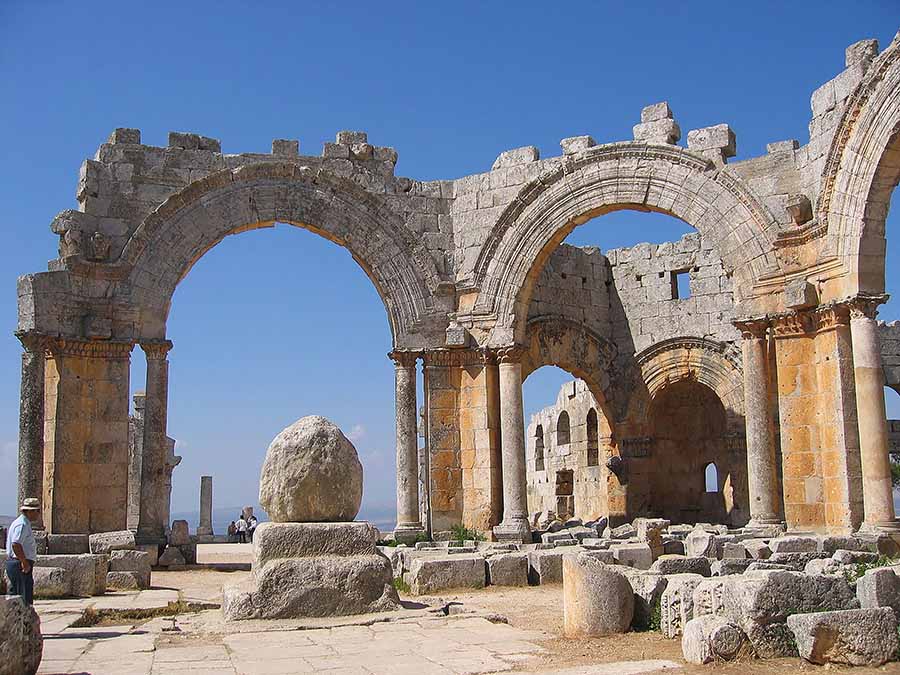
St. Simeon Stylites was a Syrian ascetic saint who lived from c. 390 to 459 and was famous for living 37 years on a small platform atop a pillar, which led to the term “stylite” from the Greek word “stylos” meaning pillar.
- The Church of Saint Simeon Stylites – Approximately 30 km northwest of Aleppo, in Syria, this is the site of the famous pillar (or stylos) where St. Simeon lived for 37 years (or 42 years as other texts claim). The base of the pillar can still be seen, although the original column has mostly disintegrated. On 12 May 2016, the site suffered damage when the pillar was reportedly struck by a missile, likely from Russian aircraft supporting the Syrian government.
- Qalaat Semaan (Fortress of Simeon) or Deir Semaan (Monastery of St. Simeon) – Surrounding the pillar are the remains of a monastery complex where monks would have lived and supported St. Simeon. The complex includes the remains of a Byzantine church and monastery. The grand complex comprises four basilicas arranged in a cross shape around an octagonal courtyard, with the remains of St. Simeon’s pillar at the centre. Often referred to as the Four Basilicas, it represents an important pilgrimage location for early Christian history.
- Museum of Antioch – The Museum of Antioch holds artifacts and information related to St. Simeon and the early Christian period in the region. After the death of St. Simeon Stylites, a dispute arose between Antioch and Constantinople over the final resting place of his relics. Antioch was ultimately chosen, and most of his remains were kept there to defend the city.
- Samalayuca Dune Fields, Chihuahua, Mexico – Location used by Luis Buñuel in his 1965 surrealist film Simon of the Desert (Spanish: Simón del desierto) starring Claudio Brook and Silvia Pinal.
- The Village of Telanissos – Near the pillar of St. Simeon, this village is part of the extended historical landscape associated with the saint. It was an early Christian settlement that later became part of the monastic complex.
- The Baptistry at the Church of St. Simeon – An integral part of the church complex, the baptistery is known for its elaborate architectural design and would have been a significant place for early Christian rituals.
- Old City of Aleppo – While the direct connection to St. Simeon might be tangential, Aleppo was a significant city during the time of St. Simeon’s life and played a pivotal role in the spread of Christianity and religious asceticism in the region.
- Saint Simeon’s Monastery in the Wadi Natrun, Egypt – Although not directly associated with St. Simeon Stylites, there is a monastery named after him in Egypt’s Wadi Natrun valley, which is historically significant for its monastic settlements.
- The Metropolitan Museum of Art, New York – Some artifacts and artistic representations of St. Simeon’s life and stylitism, such as icons and reliquaries, can be found at this museum, allowing a cultural understanding of how he was venerated.
- Mount Qassioun – Overlooking Damascus, it is said that St. Simeon before becoming a stylite, spent some time in a monastery here. It’s a place of spiritual significance with a long history of monasticism.
- National Gallery of Ireland – Here you will find a study of the Infant Christ Child held by St Simeon, c.1627 by Giovanni Francesco Barbieri.




